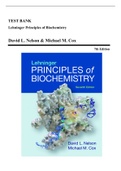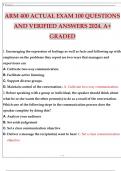Exam (elaborations)
Test Bank - Lehninger Principles of Biochemistry, 7th Edition (Nelson, 2018) Chapter 1-28 | All Chapters
- Course
- Institution
- Book
Test Bank - Lehninger Principles of Biochemistry, 7th Edition (Nelson, 2018) Chapter 1-28 | All Chapters
[Show more]





